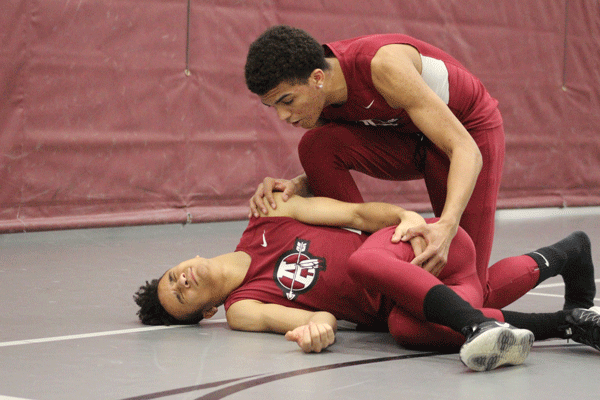An Arm And A Leg
1. Costs a lot of money. 2. Costs more than something is worth.

Junior Javen London and freshman TreShawn Watson act out a scenario as if Watson’s track and field teammate had been injured. “If one of my teammates was hurt, I’d go up to them and tell them everything is going to be fine,” Watson said. “When you’re all wound up and hurt it makes the situation ten times worse. I’ll do my best to make them calm and go get the trainer for help.”
Maybe it’s the competition, maybe it’s the relationships, maybe it’s even the workout, but for whatever reason, athletes are willing to put wear and tear on their bodies for the games they play.
According to USA Today, children ages 6 to 19 make up $935 million a year in emergency room bills. The most common injuries seen are to the ankle, followed by the head, finger, knee and face. Participating in sports and being put at risk to all types of injuries can lead to many problems in the future. According to LiveStrong, injuries like concussions can lead to quicker cognitive decline. Ankle and knee injuries, like tears, can lead to arthritis and in younger children, injuries to growth plates can lead to bone deformity.
Antioch’s certified athletic trainer, Ryan Naes, has seen many different injuries throughout his nine years as a trainer. The most shocking injury he has witnessed was a dislocated knee. The entire knee was separated laterally and the lower half was sitting next to the upper half of the knee. Naes said that injuries like these have the potential for the loss of a limb.
Despite seeing gruesome injuries, Naes understands why athletes still play, being a former athlete himself.
“Oftentimes people say they love the game so much they are willing to put their body on the line,” Naes said. “Whether that’s a professional coming back from an injury or a high school athlete, their passion for the game supersedes any potential factor for risks that they are willing to take.”
This is especially true for junior Cameron Norris, who is going into his senior year of football next year. Norris has been playing football since the age of seven. Over his ten years, he has suffered from a bruised spleen, a torn labrum, a collapsed lung, as well as an estimated ten or more concussions. Despite all of his injuries, he has continued to play football.
“I think at the end of the day it’s something that you love,” Norris said. “It’s something that is worth the risk.”
Along with potential for arthritis in his knees later in life, Norris is also concerned about what ramifications there will be with all of the concussions he has had in his past. Talk in recent years involving National Football League players developing Chronic Traumatic Encephalopathy (CTE) and memory loss has made Norris stop and think.
According to PBS Frontline, high school football players are twice as likely to suffer a concussion than college players. Along with that, football is the leading sport that suffers from head injuries, followed by ice hockey and lacrosse.
While researching the brains of deceased football players, Ann McGee, MD at Boston University, discovered signs of CTE in 18-year-old Eric Pelly who died after suffering his fourth concussion during his senior year of high school. Along with Pelly, she also found signs of the disease in 21-year-old Owen Thomas, a former Penn State football player who committed suicide.
Concussions resulting in death at a young age are very uncommon, but multiple can result in lifelong symptoms including problems with attention, short term memory, difficulty performing daily tasks and feeling “slower” overall, according to Concussion and Brain Injury Clinic.
Antioch’s football and track and field coach Del Pechauer has seen the way injuries have been treated over his 40 years of experience. When he started working at Antioch Community High School, the athletic trainers were not at practices. They would be up in the building while practices were taking place. Along with that, the way that athletes are taken care of has changed.
Back when Pechauer was playing football, the way that the coaches determined if the player had a concussion was if he could tell how many fingers the coach was putting up. If the athlete could tell, he just “had his bell rung.” With all of this in mind, he doesn’t think there has been any change in the amount of injuries over the years, but the way that they are being treated is with more caution. Back in his day, if you were hurt, you played through it. Pechauer has suffered from a couple injuries, including a separated shoulder while playing college football. Even with the injuries, he said he wouldn’t change anything. The love for the sport and relationships he built were worth it.
“You enjoy the game,” Pechauer said. “There’s something about it. It’s not for everybody. Not everybody can run into people. Not everybody can get knocked down and get back up again.”
The relationships are what also kept and still keeps him going. His friends in high school were all football players, and some of them are still his friends.
The relationship aspect of sports isn’t just secluded to football. It is just as applicable in other sports as well. For senior Alexa Spokas, the relationships she builds while playing volleyball is one of the reasons she loves the sport.
“The sport is different to me,” Spokas said. “It is a way for me to have fun but also be competitive with my friends. It’s kind of a relief from everyday life.”
A lot of Spokas’s close friends she has are from volleyball. She said that her volleyball team had a family feeling to it that she enjoys. It’s not just the family feeling that she loves, but the sport itself. She has become even more aware of this after her leg buckled this past season causing her ACL and meniscus to tear. After the injury and during rehab, she was dying to play her sport even more.
“I want to keep playing,” Spokas said. “Even though I may be afraid to at first, and I may be afraid to jump, I just have to get used to it.”
Spokas’s reaction to her injury is the type that Antioch’s trainer Naes is used to seeing.
“You’re angry.” Naes said. “You’re sad. You’re grieving.” Naes said. “There is a whole step-by-step process that people usually go through before they come to grips with it and realize that their season is over.”
Naes said that seeing the athletes go through those stages is one of the worst parts about his job. However, seeing the athlete come back from it is the best part.
“I think a lot of times people identify themselves as athletes,” Naes said. “It’s who you are. You are an athlete. You seek that competition with others. You want to be a part of a team. It’s that kind of stuff that trumps the potential risk factors.”
Those risk factors are the type of thoughts that athletes who love their sports can’t let get to their head.
“If you think about it, you don’t go 100 percent,” Pechauer said.
Naes said that the decision someone makes to play a sport should be an informed one. The more information the athlete knows about themselves concerning injures, the better decision the athlete will make.

